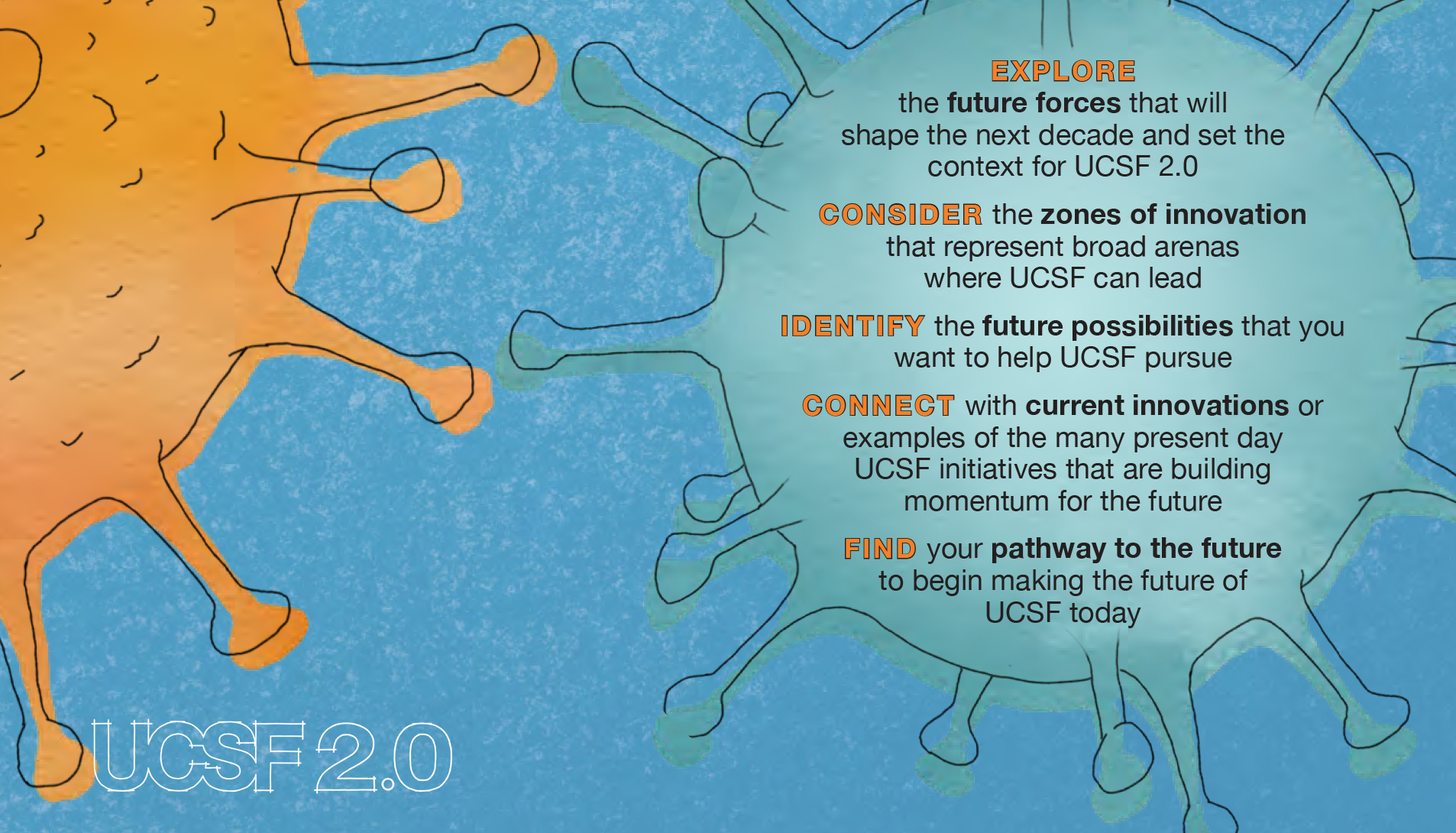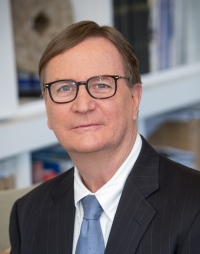UCSF Sets Future Vision for Innovation Through Inclusive Planning Process

As UC San Francisco marks 150 years since its start as a medical college, the University is looking ahead at how it will continue to lead the next revolutions in health, education and science.
Over the past eight months, UCSF has engaged the campus community to help shape the future in a strategic and inclusive planning initiative known as UCSF 2.0. The process involved focus groups, daylong workshops and the novel UCSF2025 online game in which nearly 2,600 people contributed more than 24,600 ideas during a 36-hour period last September.
All the ideas generated from UCSF 2.0, ranging from grandiose to granular, have been summarized and categorized into six themes or “innovation zones” relevant to UCSF by the research organization Institute for the Future.
The good news is that UCSF – both at the individual and institutional level – is already leading efforts across all six areas of innovation.
“The vision that came out of UCSF 2.0 is very exciting,” said Nancy Adler, PhD, director of the Center for Health and Community (CHC) who played the game as part of team CHC, the online game’s third most followed and prolific group of contributors.
What Do You Think About UCSF's Areas of Innovation?
- Create distinctive new partnerships to advance human health
- Convert data to knowledge, understanding, insight and action
- Bring precision to the full spectrum of research and health
- Catalyze citizen empowerment and engagement
- Build and enhance a transformative culture and environment
- Reinvent learning and education
What do you think about UCSF’s innovation priorities? How do you fit into these visions for the future? Over the next five months, Inside UCSF will post one big idea to the Inside UCSF blog. Comments and questions are welcome.
Adler, among others, contributed strongly to the idea that UCSF take the lead to make San Francisco one of healthiest places on the planet, particularly focusing on children and seniors.
“San Francisco is seven miles by seven miles,” said Adler, a member of the faculty since 1975. “It’s not huge and so for me it’s something that you can get your arms around and work with the community to make it happen, which I think would be harder if we were in LA or New York.”
Faculty and staff across UCSF welcomed the opportunity to discuss in depth how the University can better position itself to excel amid a rapidly changing landscape. The consensus is that UCSF must pursue bold innovations to lead in a landscape of rapid and accelerating change.
“Some innovation will come from UCSF, but we have to be open to the possibility or probability that many of them will come through partnerships outside of UCSF,” said Robert Wachter, MD, chief of the medical service and chief of the Division of Hospital Medicine at UCSF Medical Center. “The same kind of partnerships that we built with biotech and in drug development we now really need to build with organizations that are trying to reinvent health care. I think it’s very important that we don’t see that as threatening, but creating opportunities for new links with innovative and entrepreneurial companies.”
Moving Forward with an Ambitious Agenda
UCSF 2.0 opened the doors for faculty and staff to think about exciting new possibilities and voice their thoughts on how UCSF should proceed in the next decade and beyond. Ultimately, UCSF’s next chancellor and the leadership team will set the direction for the University.

Sam Hawgood, MBBS
Meanwhile, Interim Chancellor Sam Hawgood, MBBS, says that under his watch, the University will continue to advance on multiple fronts, including ideas generated in UCSF 2.0.
“As we commemorate our 150th anniversary, UCSF is not content to rest on its laurels,” Hawgood said. “We will pursue our plans for major projects and programs, ranging from advancing precision medicine to creating a UCSF health system.”
One long-term vision is for UCSF to lead a statewide strategy for the six UC medical centers to spur clinical and educational innovations, collaborate on research, train future health care workers and shape policy.
UCSF 2.0: A Consensus to Embrace Innovation
The consensus among those who participated in UCSF 2.0 – as well as those who were interviewed for this story – is that UCSF must embrace its innovative and entrepreneurial spirit by focusing on six key approaches to:
- amplify its network of collaborators and build its reputation as a convener of great innovators;
- adopt new data-driven approaches to research, health and education;
- lead the way in cradle-to-grave precision care, tailoring prevention efforts and treatments across the lifespan;
- leverage high-tech, high-touch and low-cost approaches to increase health care equity and make care more accessible;
- find new ways to foster a campuswide effort to connect across siloes, break down barriers and foster new innovations; and
- use open education platforms and new collaboration tools to reinvent what it means to teach and learn.
UCSF is pursuing a clinical enterprise strategy to create a UCSF health system, engaging partners, such as the recent affiliation between UCSF Benioff Children’s Hospital San Francisco and Children’s Hospital & Research Center Oakland, now named UCSF Benioff Children’s Hospital Oakland, to improve care in the region.
The stakes and ambitions may be high, but the future looks bright, UCSF leaders say.
“I’ve been involved in health care for more than 20 years now and this is by far the most exciting time to be looking at meaningful improvements in health care,” said cardiologist Michael Blum, MD, who directs the UCSF Center for Digital Health Innovation. “We have a whole new set of tools. We have new insights into genetic-based science. We have new models of health care, which are giving us great new opportunities to deliver high quality care. UCSF is right at the forefront of all of these areas. So it’s a great place to be and a great time to be here.”
UCSF has set an ambitious agenda over the next few years that will transform the University across all its mission areas. The plans, which echo or align well with the ideas raised in UCSF 2.0, include:
- opening UCSF Medical Center at Mission Bay on Feb. 1, 2015 and creating a UCSF-led health care system to deliver effective, coordinated, patient-centered care that improves health outcomes across the entire care continuum;
- testing, validating and adopting new tools and technology to advance patient and consumer engagement in digital health;
- building a UCSF-wide platform to coordinate and support advances in the nascent field of precision medicine;
- forging new partnerships that rally a range of public, nonprofit and private sector stakeholders to promote enhanced community and global health; and
- transforming teaching and learning by taking a holistic and interdisciplinary approach to health sciences education.
For many in the UCSF community, UCSF 2.0 was an opportunity to have their voices heard on a number of topics.
"We thought the exercise was fabulous and we've been involved in the followup working sessions," said Jim Hine, executive director of campus procurement at UCSF and UC Berkeley. Hine and team campus procurement are putting their UCSF 2.0 ideas into action. The administrative unit has pursued partnerships internally to better serve campus researchers and externally with suppliers.
They worked with partners across several UC campuses to secure a grant from the University of California Office of the President to create a UC-wide core for genomic sequencing, reducing University costs by sharing expensive sequencing equipment across the system rather than campuses making their own purchases.
UCSF is also implementing a number of short-term ideas to enhance campus life and further the University's efforts in sustainability, particularly in transportation services.